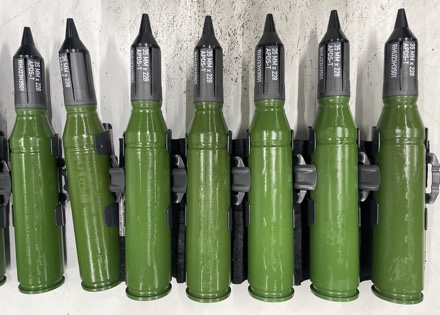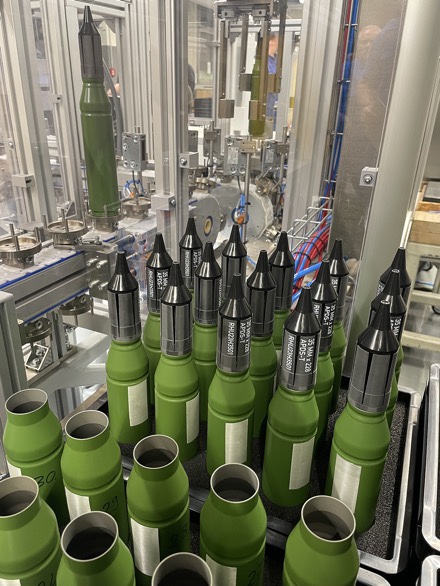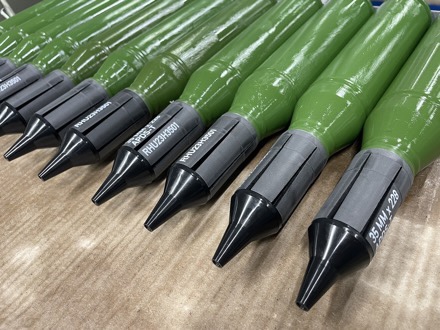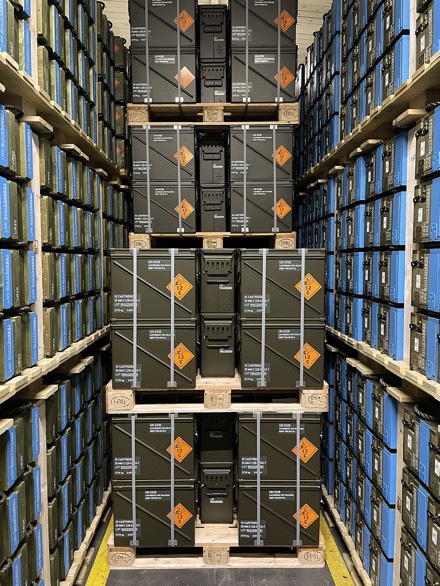A first shipment of new ammunition for the Gepard antiaircraft tank is now headed for Ukraine. Per agreement, Rheinmetall AG of Düsseldorf has shipped a first lot of 35mm air defence ammunition as part of German support for Ukraine’s defensive struggle. By the end of this year, 40,000 rounds are to be produced and provided.

In Ukraine the shipments from Germany are eagerly awaited: with its 35mm twin guns, the Gepard has emerged as a decisive factor in the embattled nation’s fight to defend itself. The German government has made 46 of these antiaircraft tanks available, with another six to follow. For Ukraine, they play an essential part in the struggle to control its airspace, having proved highly effective in countering the kamikaze drones Russia uses to attack Ukrainian cities. They are almost permanently in action, making ammunition consumption correspondingly high.
Rheinmetall has long produced much of its ammunition for medium-calibre weapons in Switzerland; now, however, new production capacity for supplying the Gepard systems has been created in Germany, where a multimillion-euro figure has been invested in plant and equipment.

In February 2023 Boris Pistorius, the German defence minister, announced at a meeting of the Ukraine Defence Contact Group that capacity for producing ammunition for the Gepard would be created in Germany at Rheinmetall. A contract for the rapid delivery of a total of 300,000 rounds of ammunition for the antiaircraft tank had already been signed several days earlier. Owing to the urgency and high political relevance of the project, the pressure to complete the new facility was immense from day one, requiring a true technological and logistical tour de force.
In the words of Rheinmetall AG executive board chairman Armin Papperger, “We keep our promises. Just six months after signing the contract, we’ve already started delivery, as agreed. My sincere thanks go to the men and women of Rheinmetall who have done so much to make this project a success, even working on weekends. Our subcontractors and vendors deserve praise as well, having helped us to achieve what at first seemed impossible. The pressure to succeed was huge – but so was our commitment to getting the job done. We want to help the people of Ukraine. Every drone that’s shot down saves lives!”

The German government left no stone unturned in its effort to supply Ukraine with fresh ammunition, including abroad – albeit in vain. In Germany stocks of the ammunition had dropped to zero, as the Gepard systems had been retired from service some fifteen years earlier. Other countries declined to make available existing stocks of ammunition, citing either political considerations or constitutional restrictions.
In the end, it was a tightly woven intermeshing of expertise of Rheinmetall technicians and engineers in Switzerland, Germany and Italy that made creating the new production facility possible.
The problem: earlier tools for producing the original ammunition were simply no longer there. The solution turned out to be a mix of reverse engineering and adaptive development quite unlike anything seen before: existing 35mm ammunition from the main armament of an infantry fighting vehicle was modified for use in the Gepard. Making sure that the Gepard fire control unit could reliably recognize the ammunition was a special challenge.
Despite their excellent performance, the electronics and fire control technology of the aging antiaircraft tank – developed in the 1960s – proved to be a veritable black box. At the same time, the supply chain for the new ammunition had to be expanded in order to minimize as far as possible the Swiss value-added share.

As Armin Papperger puts it, “We have an unbeatable strength at Rheinmetall: namely, the broad-based expertise that comes with being a systems house. Whether in ammunition development, mechanical production and materials knowledge, in the development of air defence weaponry, in comprehensive live fire testing, in the design and construction of production facilities – everywhere our experts worked with tremendous drive and great personal commitment to complete the project. They knew how urgently Ukraine needed the ammunition – and the sooner, the better.”
Following multiple tests at the Group’s proving ground at Unterlüss in Lower Saxony, the verification programme was concluded in May 2023 when the ammunition was successfully fired by a Gepard antiaircraft tank.
Meanwhile, at one of Rheinmetall’s civil sector plants in Neuss, an LAAP line was designed and subsequently built at a Group facility in Lanciano, Italy, before being transferred to Unterlüss. LAP stands for loading, assembly and packing, the process in which the cartridges are loaded with propellant; the various parts of the round are put together; and subsequently packaged. The propellant powder comes from Nitrochemie, by the way, another member of the Group.
A total of 40,000 rounds are to be delivered this year. Ukraine will be receiving 150,000 rounds each of two different types of ammunition. One of these is a subcalibre APDS-T munition containing heavy metal penetrators, and thus especially suitable for engaging hardened targets. Rheinmetall is also supplying Ukraine with conventional HEI-T high-explosive incendiary ammunition designed for bringing down typical air defence targets, e.g., aircraft and guided missiles.


So are they finally going to start that big “counter-offensive” we keep hearing about?
Beautiful array of projectile porn. Sadly, far too little, far too late. One thing that is interesting is with ever more cheaper drones, you could possibly see parity in cost if not outright cheaper drones than the price of one of these shells. If a 1 or 2 second burst is necessary to deter or kill a cardboard kamikaze drone, that means you’re still talking 30-40 to 1 economization ratio, and 7 or 8 bursts before the Gepard is out of ammo.
In other words, in the future even uber-cheapo SPAAG platforms wont be cost effective – or survivable – in heavy drone environments where 90% of the swarm is knocked out but still achieve their objective. If active kill mechanisms are still necessary for high priority targets, the only thing I see with the speed and multi-target tracking capability is lasers.
I mean, Ukraine wasn’t going to “win” anyway. Simple logistics dictated that back in 2014 when the war started. All the people shilling for the money launderers, warmongers, and child predators benefitting from this incident seem to forget that.
By the end of the year, Ukraine will have lost another 250-400,000 troops at the current rate of losses. This is unsustainable even if Ukraine mobilizes another 500,000 – which is improbable. Plus, 500,000 press-ganged civilians are useless against modern weapons systems.
By the end of the year, will any Gephards still be running? They’re hardly invulnerable to various Russian kamikaze drones.
Anyone with a brain who understands the term “military balance” could look at any of the descriptions of same which were published in many newspapers and Web site prior to the start of the war and clearly see that Ukraine, no matter how much support it gets from NATO, could not possibly win a war with Russia.
Hell, every NATO war game run in the last ten years has shown that any war between NATO and Russia ends in one of two ways: 1) NATO loses, or 2) nuclear WWIII.
Oh I’m sure they’ll be running, right into the black arms market or the militaries of Russia and China.
The war game results don’t seem very likely, but then again most “war games” have a habit of imposing severe ROE and other use of force restrictions on the US.
How can you look at Russia’s performance and conclude they could defeat NATO?
Why are you acting as if this isn’t how Russia’s been fighting most of their wars for the last two centuries?
They were losing against Napoleon in 1812.
They were losing against the Finns in 1939.
They were losing against the Nazis in 1942.
They were losing against the Chechens in 1994.
Given that most of the militaries of NATO are entirely reliant on the US for any real conflict and have been underfunded for years, it stands to reason that they sure as fuck wouldn’t have an easy time.
They were losing against Japan in 1905.
They were losing against Germany in 1917.
They were losing against Afghanistan in 1988.
And they’ve never fought the USA.